As two super-powered options for home energy, the battle between the EcoFlow Delta Pro Ultra vs. Bluetti EP900 is one to watch. It’s hard to find anything more capable than either system with both ready to provide long-lasting power to even your most energy-hungry appliances.
While these two power systems have relatively similar specs and capabilities, there are many differences. And this detailed comparison is here to help you understand what those are so you can choose the one that’s best for your needs. We’ll translate the complicated specs into meaningful real-world takeaways, including what these can power and for how long.
By the end, you’ll know whether the EcoFlow Delta Pro Ultra or the Bluetti EP900 is better for your situation.
We carefully select the products and services we link to. If you buy through our links, we may earn a commission. There’s no extra cost to you and it helps us provide this information.
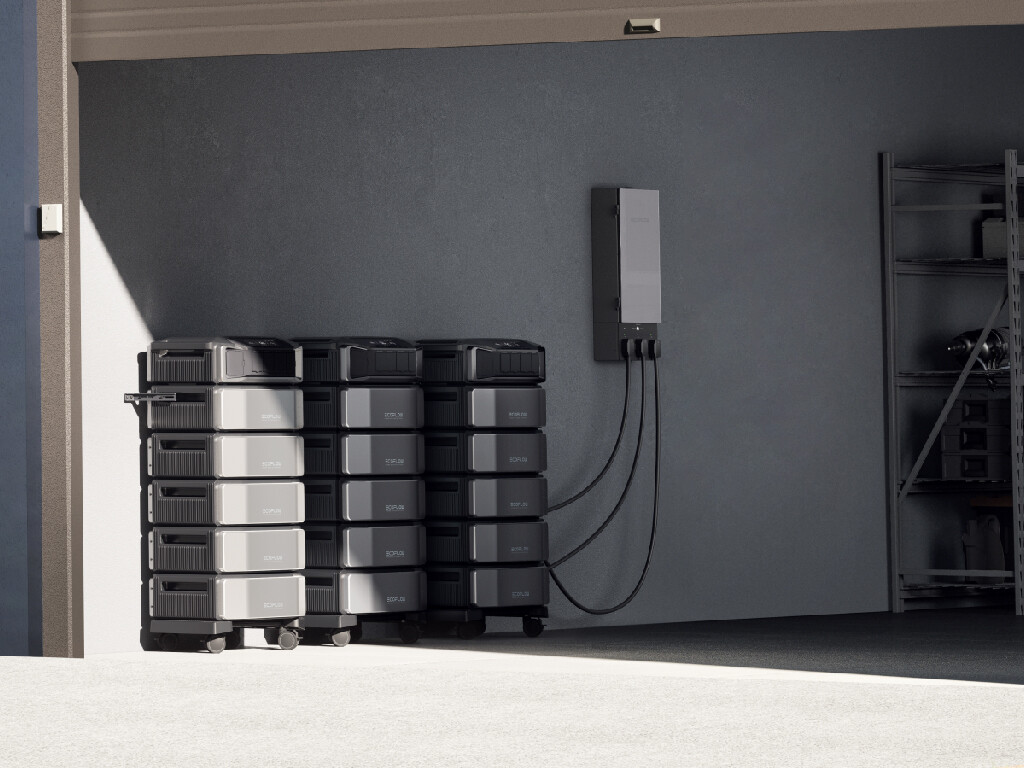
Quick Breakdown: Big Portable Power or Grid-Friendly Giant
When it comes to well-designed power stations that are ahead of the rest, EcoFlow and Bluetti are brands that know how to deliver. They’ve raced onto the scene and continued to forge a new pathway forward, offering a variety of innovative power stations. And now they’re reaching into massive whole-home battery backup systems.
The EcoFlow Delta Pro Ultra and Bluetti EP900 both offer the raw power ready to tackle serious energy needs. These are currently the two most powerful options from both companies. You’ll find massive battery capacity and inverter power on either system. We see both systems as very attractive options that are well-suited for specific needs. Yet they are far from identical.
The Bluetti EP800 is identical to the EP900 in every way except the inverter output. The EP900 can deliver up to 9kW per unit while the EP800 is limited to 7.6kW per unit. This entire comparison applies to the EP800 as well.

After careful review, we recommend the EcoFlow Delta Pro Ultra as the more user-friendly and versatile solution because it has:
- Higher maximum battery capacity and inverter output
- User-friendly connections with easier installation
- Portable design allows for additional usage away from home
However, there are some situations where the Bluetti EP900 is the better choice, especially if you’re planning a more permanent home-based setup with maximum solar panels. Here’s what it offers:
- Vastly superior solar input
- Double the warranty coverage
- Can sell excess energy back to the grid
The biggest downsides for the Bluetti EP900 are that it has a bulkier design, lacks traditional outputs and ports, and can only be used through a semi-permanent installation, compromising portability.
When it comes to price, you’ll find the minimum Bluetti system is much more expensive. Yet that minimum package has more battery capacity and inverter power. If you equalize the price comparison by comparing cost per battery Wh, you’ll find the MSRPs of both systems are a touch over $1.00 per Wh.
However, EcoFlow almost-always offers discounts, allowing for a price per Wh closer to $0.85. As a result, the EcoFlow Delta Pro Ultra is usually a better value than the Bluetti EP900. It also has a much lower cost for the minimum system.
Don’t overlook the 30% solar tax credit. Many people can get big bucks back at tax time when buying these units with large batteries for home backup. This EcoFlow and Bluetti may both be qualified purchases, along with solar panels and other necessary accessories.
The EcoFlow Delta Pro Ultra takes our recommendation over the Bluetti EP900. It is easier to work with, provides better maximum capabilities, and offers portable use. The Bluetti EP900 is an extremely capable system that’s great for home backup use if you prioritize selling power back to the grid provider and you want to maximize your solar panel usage.
Get 5% off most EcoFlow orders with SOLARWAY5OFF discount code.

|
EcoFlow DELTA Pro Ultra |
DPU on EcoFlow DPU on Amazon |

|
BLUETTI EP900 |
EP900 on Bluetti |
In-Depth Comparison: EcoFlow Delta Pro Ultra vs. Bluetti EP900
Whatever power station you go with, your choice should strike the right balance of power, performance, and portability. While these two options bring a lot to the table, it’s time to break down the key specs to help you make the best choice.
Here’s what we’ll be looking at:
- What Can These Power? Inverter and Outputs
- How Long Do They Last? Battery Details
- How Fast Can They Charge? Charging Inputs
- How Easy to Move? Portability and Dimensions
- What’s the Bottom Line? Final Verdict

Power That Packs a Punch: Inverters and Outputs
Inverters turn the stored DC (direct current) energy in your power station’s battery into the AC (alternating current) power that most of your household devices use. Think of it as the translator between your power station and the gadgets you rely on.
The size of the inverter determines how much power it can convert at once, which directly affects what kind of devices you can run. That’s where the EcoFlow Delta Pro Ultra (DPU) and Bluetti EP900 go head-to-head.
Raw Inverter Power
The Delta Pro Ultra packs a 7,200W inverter while the Bluetti EP900 starts at 7,600W inverter output. And if you use more than two battery packs with the EP900, that immediately unlocks more power to 9,000W from one unit.
Whether you’re using the 7.2kW EcoFlow of 9kW Bluetti, these are insanely powerful inverters. They can power a practically limitless amount of small and medium devices, as well as some of your home’s largest appliances.

Here’s a quick look at the energy use of common devices:
- Low wattage (Up to 100W): phones/tablets, WiFi routers, laptops, LED lights.
- Medium wattage (200W to 500W): Televisions, desktop computers, refrigerators.
- High wattage (1,000W to 2,000W): Coffee maker, microwave, hairdryer, some induction cooktops.
- Heavy-duty wattage (3,000W and up): Whole home air conditioner, electric dryer, large electric appliances.
Let’s say you want to keep your fridge cold, TV on, WiFi running, lights on, and a few small devices charged up. That’s around 600W total continuous energy use, practically nothing for these giant inverters.
When you turn on the microwave, that could add another 2,000W. If you turn on a hairdryer and the coffee maker with all of this running, you might be approaching the limits of these inverters. And whenever you’re using a heavy-duty appliance – including large air conditioners – you might be getting close to the max capability. The startup surges can be especially problematic.
For those that need even more power, you can use more than one inverter unit in unison. The EcoFlow Delta Pro Ultra is designed to use up to three units for a maximum inverter output of 21.6kW. Most homes will be very well covered with just two DPUs, offering 14.4kW.
The Bluetti EP900 can use two inverter units together at most. That’s 18kW of power. This is going to be more than sufficient for most needs, but it is 3.6kW less than the max EcoFlow DPU system.
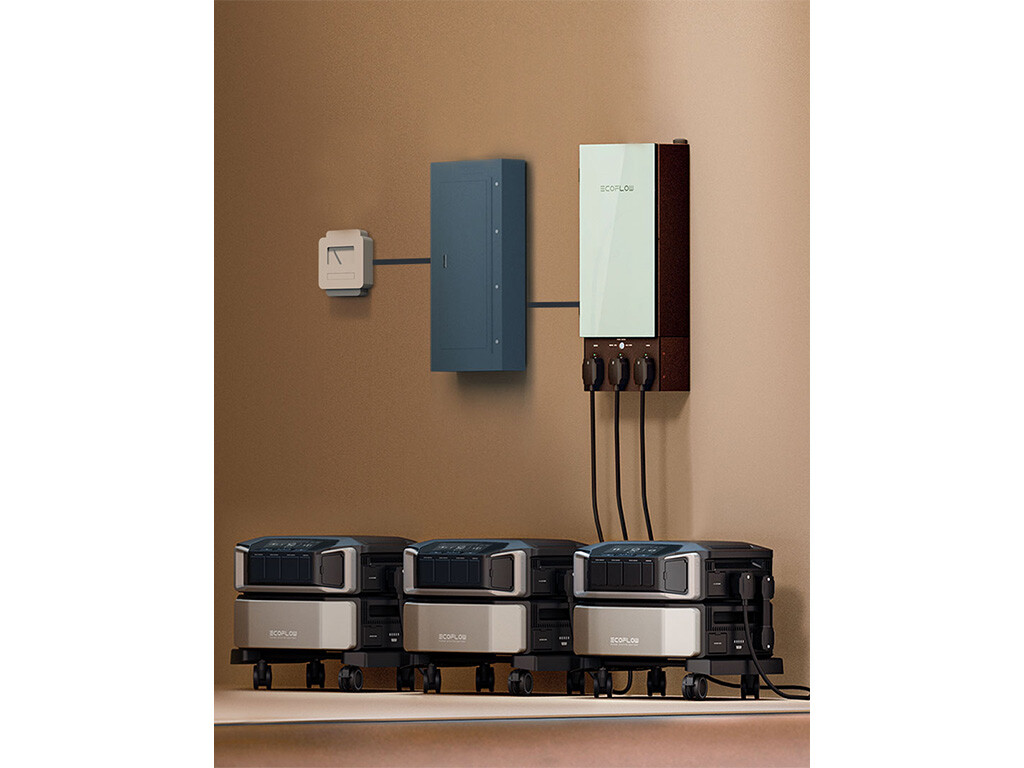
Home Integration and Connection Options
The best way to integrate these power stations with your home is to use a transfer switch and critical loads panel. Connect your most important loads to this panel then have the ability to switch between grid power and battery backup.
The Bluetti EP900 uses a more direct connection to your subpanel. You must wire the output of the Bluetti to your transfer switch and subpanel (the input side is also directly wired). It’s not just a regular plug or a high-amp connector. The installation is fairly quick, but it’s also more permanent. You’re not going to want to undo this to bring the Bluetti away for a trip or event.
One major advantage of the EP900 is that it has a grid communication ability which can send power back to the grid, like common grid-tied solar systems. The DPU works entirely separate from the grid, allowing you to choose between grid power or battery backup, but it won’t sell excess power back to the grid.
The EcoFlow Delta Pro Ultra has two advantages when it comes to home integration:
- It uses easy-to-connect plugs and outlets to power your transfer switch and critical loads.
- EcoFlow offers a specific automatic transfer switch, the EcoFlow Smart Home Panel 2, with a subpanel that offers more customization and settings through the EcoFlow app.
The Delta Pro Ultra is easier to connect and disconnect as desired. And while it’s a large and heavy power station, you can use it in your RV for a couple weeks or take it to a remote event to provide a power supply.
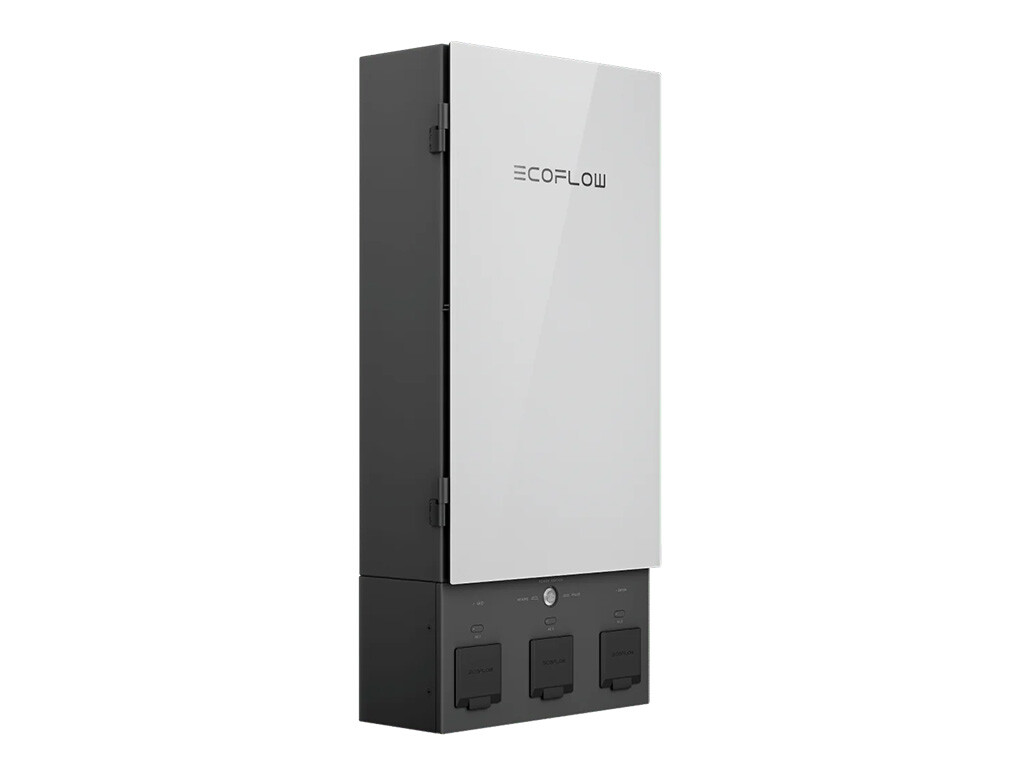
|
EcoFlow Smart Home Panel 2 |
SHP2 on EcoFlow |
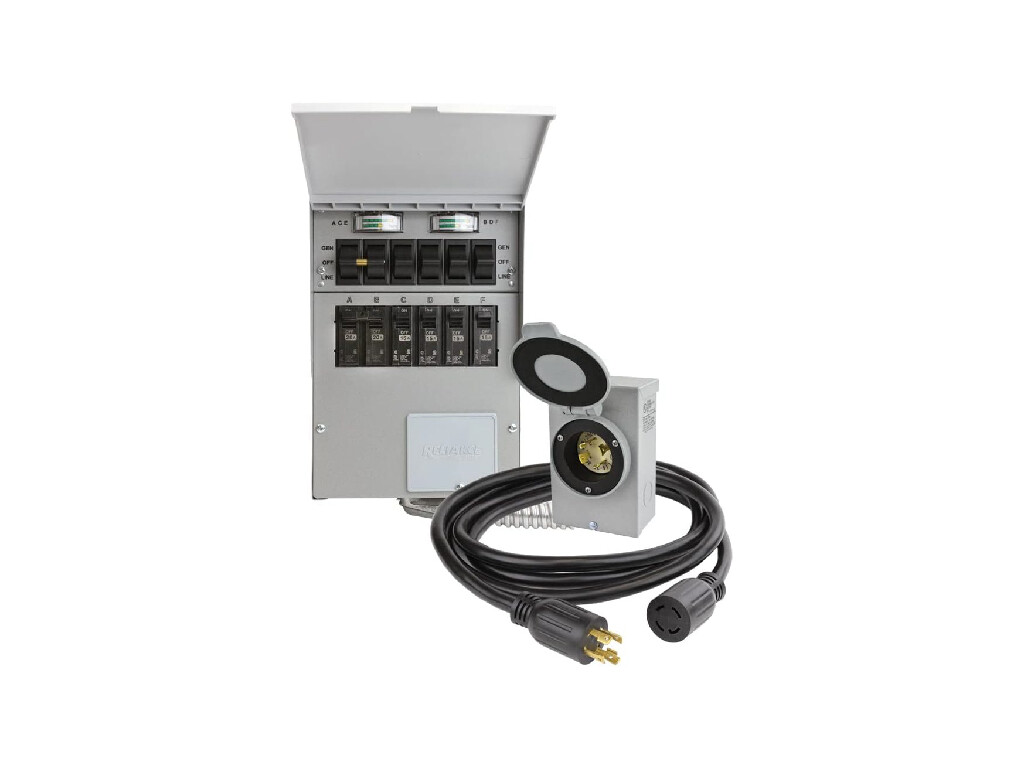
|
Reliance Controls 306CRK Transfer Switch Kit |
Buy on Amazon |
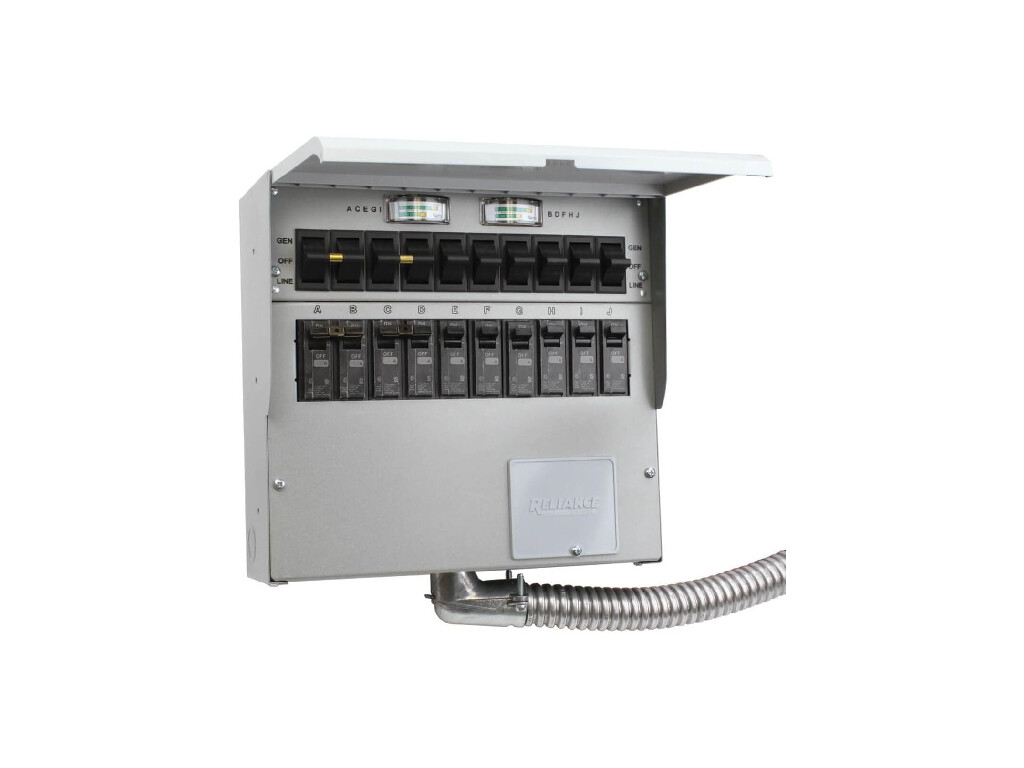
|
Reliance Controls 510C 50-Amp Manual Transfer Switch |
Buy on Amazon |
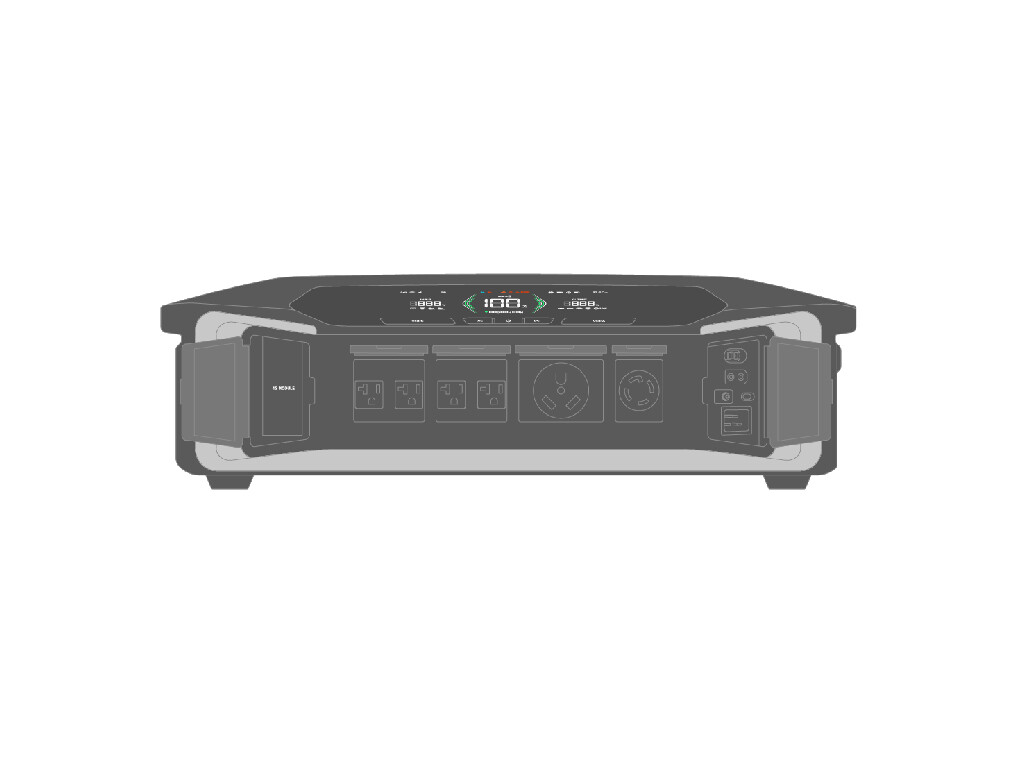
Another advantage of the DPU is that it offers a wide variety of regular outlets and ports, including four 120V AC outlets, two high-amp outlets (one at 240V), and a handful of USB ports. You can run devices large and small directly from it. You can also plug it into your RV’s shore power inlet using high-amp power without making any modifications to your RV. This is impossible with the Bluetti
The Bluetti EP900 does not offer any regular connections. You MUST use it through a subpanel.
These two heavy-duty power stations include Uninterruptible Power Supply (UPS) capabilities. This means they automatically switch to battery power when your main power source goes out, keeping critical devices like computers, CPAP machines, or WiFi routers running without interruption.
- EcoFlow Delta Pro Ultra: online UPS with 0ms transfer time from some outlets and 20ms from others
- Bluetti EP900: 10ms transfer time through its only output (wired connections)
Output Verdict: With higher maximum inverter output, more versatile connections, and a design that allows for portable use, the EcoFlow Delta Pro Ultra has superior inverter and output features. It also has online UPS with 0ms immediate switchover. The Bluetti EP900 has higher single-unit inverter output and is best for stationary setups and full-home use, allowing for selling excess energy back to the grid.
| Product | EcoFlow DELTA Pro Ultra | BLUETTI EP900 |
|---|---|---|
| AC Output | 7,200W | 7,600W |
| AC Output (System Max) | 21,600W | 18,000W |
| 120V Outlets | 5 (4x20A, 1x30A) | 1 |
| 240V Outlets | 1x30A | 1 |
| UPS / EPS | 0ms / 20ms | 10ms |
| USB-A Ports | 2x15W | – |
| USB-C Ports | 2x100W | – |
| Other DC (Anderson or other) | 1x378W (30A) | – |
| Connectivity | WiFi / Bluetooth / 4G | WiFi / Bluetooth / USB |

Power That Lasts: Battery Details
The battery is the backbone of these systems, dictating how long you can keep your devices running. Both the EcoFlow Delta Pro Ultra and Bluetti EP900 pack impressive watt-hours (Wh), which measure the total amount of energy stored in the unit.
The EcoFlow Delta Pro Ultra starts with a single 6,000Wh battery, while the smallest Bluetti EP900 system includes two B500 batteries for a total of 9,920Wh. While the Bluetti system is higher, it’s also significantly more expensive. It’s a more fair comparison to include at least one extra DPU battery, which immediately goes to 12,000Wh (higher than the Bluetti EP900).
Here’s how that translates to daily use:
- A 60W laptop could run for roughly 80 hours on the Delta Pro Ultra or about 130 hours on the Bluetti EP900.
- A 600W load, like a home power backup of critical devices and appliances, would last for around 8 hours on the Delta Pro Ultra and closer to 13 hours with the Bluetti.
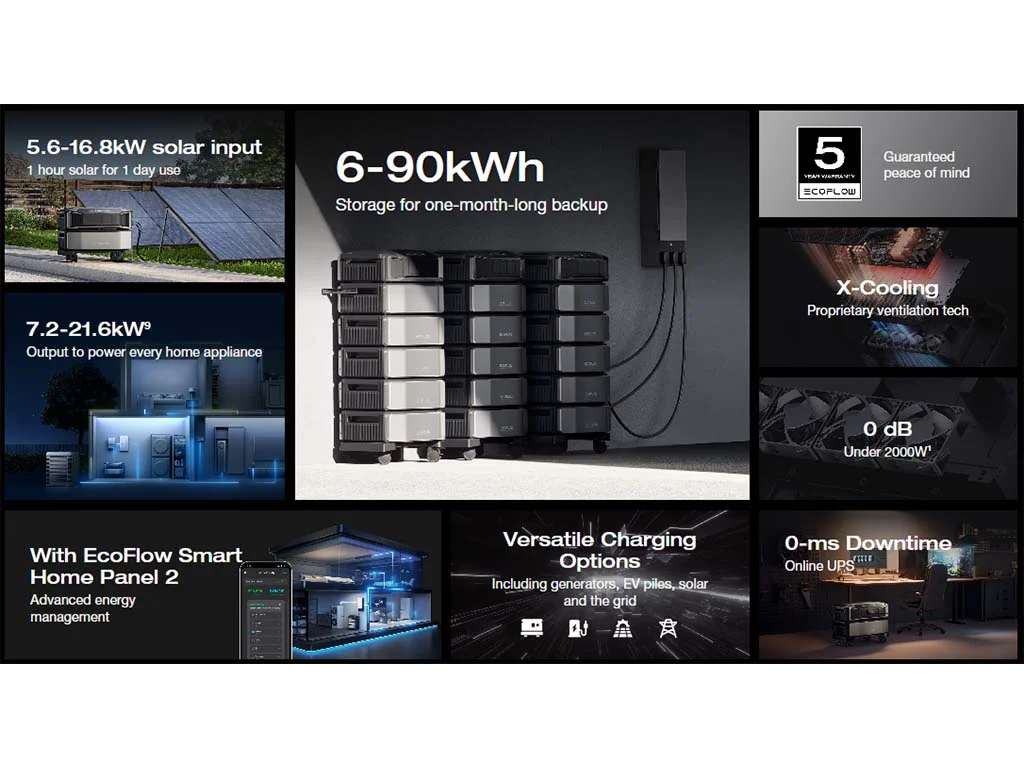
If that’s not enough time, you have plenty of room to grow with both systems:
- The EcoFlow Delta Pro Ultra can scale up to an astonishing 90,000Wh with extra battery units. You can use five batteries per DPU inverter unit. The maximum system is three DPUs with 15 batteries.
- The Bluetti EP900 maxes out at 39,680Wh, including four B500 batteries on each EP900. The maximum system is two EP900s with eight B500 batteries.
The DPU maximum battery capacity far exceeds that of the EP900. As the more portable system, this may be surprising to see. The fact is that EcoFlow has done an exceptional job at offering the ability to grow the Delta Pro Ultra to meet almost any power needs. It will last days of serious home backup power or weeks of critical device usage (including a fridge).
Both power stations use LiFePO4 (LFP) batteries rated for over 3,000 cycles. That’s about 8 years of daily use before they dip below 80% of their original capacity. They’re made to serve as long-term solutions with many years of value-adding power potential. And even after these 3,000 cycles, they’ll still work just at a lower capacity.
When it comes to warranty coverage, Bluetti has the major advantage:
- EcoFlow Delta Pro Ultra: 5-year warranty
- Bluetti EP900: 10-year warranty
This 10-year coverage is absolutely incredible. Many providers offer 5 years as the standard warranty coverage, including the majority of Bluetti power stations. By taking the EP900 to 10 years of manufacturer warranty coverage, they’re adding an incredible peace of mind.
Battery Verdict: Despite the longer warranty and larger minimum battery capacity, the Bluetti EP900 doesn’t quite live up to the battery capabilities of the EcoFlow. With up to 90,000kWh of battery and a smaller minimum system that allows for a lower entry-level price, the EcoFlow Delta Pro Ultra has better battery specs too. Bluetti’s 10 year warranty wins some points, but EcoFlow’s 5-year coverage is nothing to complain about.
| Product | EcoFlow DELTA Pro Ultra | BLUETTI EP900 |
|---|---|---|
| Battery | 6,000Wh | 9,920Wh |
| Battery (System Max) | 90,000Wh | 39,680Wh |
| Warranty | 5 years | 10 years |
| Battery Type | LiFePO4 / LFP | LiFePO4 / LFP |
| Battery Cycles | >3,000 | >3,000 |
| Buy Now | Buy DPU | Buy EP900 |
| Buy on Amazon | EcoFlow DPU on Amazon | – |

Lightning-Fast Charging: Speeds and Inputs
When it comes to portable power stations, charging speed can make or break your experience. Nobody wants to wait all day to get their power station back to full capacity. And you want them to be able to refill even if the grid is still down. Fast charging is a key factor.
The EcoFlow Delta Pro Ultra and Bluetti EP900 are both designed with fast charging in mind. Neither one neglects this aspect of their design. Yet the Bluetti EP900 has a clear advantage here.
AC power is the quickest way to juice up these power stations. The Delta Pro Ultra can handle 7,200W of AC input power, while the Bluetti EP900 comes with a higher 8,900W input. These figures are well above a standard 1,800W AC outlet (120V / 15A). And you’ll have no problem leveraging grid power to refill either option. Just remember that the Bluetti must be directly connected. The DPU can use other outlets or even an EV charger to refill.
We view the solar charging abilities as a critical part of any power station’s design. For these monster units, solar power is what can help you lower your energy bills on a regular basis while also ensuring you have power if there’s a long-term grid failure. As long as you use the right amount of solar, it’s a reliable and sustainable way to generate power.
Here’s what each device offers:
- EcoFlow Delta Pro Ultra: 5,600W max solar input with one 450V input and one 150V input
- Bluetti EP900: 9,000W max solar input with dual 500V max inputs

The Bluetti EP900 crushes the solar game with its ability to handle up to 9,000 watts per EP900 unit. This is a simply massive amount of solar power. The incredible 500V maximum limit also makes it a lot easier to maximize your solar charging without damaging the power station. You can go crazy with series connections and not overload the power station.
The DPU’s 5,600W and 450V max are still quite impressive. Outside of the EP900, it has one of the highest solar charging capabilities on any power station. And in many cases, it’s more than enough.
The Bluetti EP900 specifies that it can function with existing solar arrays too. The DPU can only do so by charging from the grid power supply, which may be generated with existing solar panels, but it’s not specifically designed for this setup.
It is easier to use fuel generators with the DPU since you can connect basic plugs to it. A dual fuel generator can be a great thing to have around for backup power during stormy situations where solar won’t generate much electricity.
Car charging is usually too slow for these. You can get devices like the Pecron 500W Car Charger or the Bluetti 560W Alternator Charger 1 to create a faster charging option while driving your car or RV. The EcoFlow Alternator Charger is not compatible with the DPU due to different connections and higher battery voltage.
Charging Verdict: For sheer charging speed, the Bluetti EP900 is the better choice with faster AC and solar input capabilities. The 9kW per EP900 of solar with seriously high voltage limits offer an impressive solar solution. While the Delta Pro Ultra still performs admirably with up to 5,600W of solar, it’s not quite as impressive as the EP900.
| Product | EcoFlow DELTA Pro Ultra | BLUETTI EP900 |
|---|---|---|
| AC Input | 7,200W | 8,900W |
| AC Recharge Hours (Est.) | 1h | 1.3h |
| Solar Input | 5,600W | 9,000W |
| Solar Recharge Hours (Est.) | 1.3h | 1.3h |
| Solar Input (System Max) | 16,800W | 18,000W |
| Solar Input 1 Watts | 4000W | 6000W |
| Solar Input 1 Volts Min | 80V | 150V |
| Solar Input 1 Volts Max | 450V | 500V |
| Solar Input 1 Amps | 15A | 25A |
| Solar Input 2 Watts | 1600W | 3000W |
| Solar Input 2 Volts Min | 30V | 150V |
| Solar Input 2 Volts Max | 150V | 500V |
| Solar Input 2 Amps | 15A | 12.5A |

Size and Portability: How Heavy Are These?
One of the biggest advantages of portable power stations over DIY setups is their mobility. You can take them wherever you need power, whether that’s an event at the park, in an RV, or when you move to a new home.
The EcoFlow Delta Pro Ultra is a much more portable system. You can simply unplug it, throw it in your RV or car, and take it wherever you need to provide power. It has tons of connections to power devices directly, no matter where you are. However, it still weighs 70 lbs (32 kg) for the inverter unit plus another >100 lbs (45 kg) for the battery. It’s not something you’ll want to bring along unless you really need it.
The Bluetti EP900 must be semi-permanently installed to your home circuits. It does not have standard outlets or USB ports to power devices directly. And it’s made to use wired connections, not common plugs, to tie into your home circuits. You can still dismantle it to move to a new home, but it’s not a portable system.
Portability Verdict: The EcoFlow Delta Pro Ultra is the clear winner in portability. The easy-to-use connections and countless outlets mean you can bring it wherever you want and have a useful power station with massive power. While very powerful, the Bluetti EP900 must be used while stationary due to its direct circuit connections and a lack of outlets that can power your devices directly. It’s a home energy system that can be moved to a new home if needed, but it’s not portable.
| Product | EcoFlow DELTA Pro Ultra | BLUETTI EP900 |
|---|---|---|
| Weight (lbs) | 70lbs | 97lbs |
| Weight (kg) | 31.7kg | 44kg |
| Dimensions (in) | 27.2×18.9×8.4in | 25×12.8×14.5in |
| Dimensions (mm) | 690x481x214mm | 636x324x368mm |

Final Verdict: Our Recommendation
After weighing the EcoFlow Delta Pro Ultra against the Bluetti EP900, we like a lot of things about both options. Either one can deliver whole-home power to get you through power outages or lower your energy bills.
The EcoFlow Delta Pro Ultra is our preferred power station over the Bluetti EP900. The DPU has a lower starting cost, higher maximum capabilities (battery capacity and inverter power), and includes an easier-to-use design that allows for portable use. It’s simply a more powerful and friendly device.
There’s a place for the Bluetti EP900 in some homes. It offers a great way to provide long-lasting home backup power. Its vastly superior solar inputs plus extensive 10 year warranty coverage are two reasons to choose it over the DPU. Just know that you must use it as a integrated system and it’s not portable.
| EcoFlow Delta Pro Ultra | Bluetti EP900 |
|---|---|
Here’s a quick review of this power station comparison’s key points:
- Inverter and Outputs: The Bluetti EP900 has a larger single-unit inverter, but the EcoFlow Delta Pro Ultra maximum system is >3kW higher max output. The DPU also offers more versatility with its wide range of outlets and online UPS function.
- Battery Capacity: While Bluetti’s entry-level battery capacity is higher, it’s also forcing you to buy two expensive batteries. You can keep costs down with a smaller minimum EcoFlow battery setup. Or you can add on more EcoFlow batteries to reach an astonishing 90kWh of capacity, more than twice the 40kWh maximum of the Bluetti EP900 system.
- Charging Speeds: The Bluetti EP900 charges faster via solar and AC, with vastly superior solar inputs. For those that want to use more than 5kW of solar per power station, the EP900 wins. The EcoFlow DPU offers strong charging capabilities with a competitive AC recharge time and up to 5,600w of solar per DPU (16.8kW maximum across three DPUs).
- Portability: The EcoFlow Delta Pro Ultra is significantly more portable, featuring standard plugs and connections to power your devices directly off the DPU. The Bluetti is exclusively designed for stationary home backup use with integrated direct wiring and no outlets for direct power.
- Value: Not only is the EcoFlow Delta Pro Ultra starting price lower, but it usually clocks in at a lower price per Wh, offering a better value no matter the size of the system. The Bluetti EP900 MSRP is about the same per Wh, but Bluetti rarely offers it at discount and the smallest system is still a very large investment.
Final Recommendation: The EcoFlow Delta Pro Ultra takes our top spot because of its offers higher maximum power, a better value, and a more user-friendly design. It’s perfect for those who need reliable power at home and while on the move, including RV living. The Bluetti EP900 is still an excellent system that pulls ahead with higher solar capabilities and an impressive 10-year warranty. But its maximum power output and battery capacity are lower than the DPU, and it lacks portability.
Get 5% off most EcoFlow orders with SOLARWAY5OFF discount code.

|
EcoFlow DELTA Pro Ultra |
DPU on EcoFlow DPU on Amazon |

|
BLUETTI EP900 |
EP900 on Bluetti |
EcoFlow Delta Pro Ultra vs. Bluetti EP900: Specs Comparison Chart
Below is a detailed comparison chart that highlights the key specs of the EcoFlow Delta Pro Ultra and Bluetti EP900, making it easy to see how these two power stations stack up side-by-side. We’ve also listed links to the user manuals so you can find more answers to your questions about these heavy-duty power stations.
| Product | EcoFlow DELTA Pro Ultra | BLUETTI EP900 |
|---|---|---|
| Battery | 6,000Wh | 9,920Wh |
| Battery (System Max) | 90,000Wh | 39,680Wh |
| AC Output | 7,200W | 7,600W |
| AC Output (System Max) | 21,600W | 18,000W |
| AC Input | 7,200W | 8,900W |
| AC Recharge Hours (Est.) | 1h | 1.3h |
| Solar Input | 5,600W | 9,000W |
| Solar Recharge Hours (Est.) | 1.3h | 1.3h |
| Solar Input (System Max) | 16,800W | 18,000W |
| Warranty | 5 years | 10 years |
| Weight (lbs) | 70lbs | 97lbs |
| Weight (kg) | 31.7kg | 44kg |
| Dimensions (in) | 27.2×18.9×8.4in | 25×12.8×14.5in |
| Dimensions (mm) | 690x481x214mm | 636x324x368mm |
| Solar Input 1 Watts | 4000W | 6000W |
| Solar Input 1 Volts Min | 80V | 150V |
| Solar Input 1 Volts Max | 450V | 500V |
| Solar Input 1 Amps | 15A | 25A |
| Solar Input 2 Watts | 1600W | 3000W |
| Solar Input 2 Volts Min | 30V | 150V |
| Solar Input 2 Volts Max | 150V | 500V |
| Solar Input 2 Amps | 15A | 12.5A |
| Battery Type | LiFePO4 / LFP | LiFePO4 / LFP |
| Battery Cycles | >3,000 | >3,000 |
| 120V Outlets | 5 (4x20A, 1x30A) | 1 |
| 240V Outlets | 1x30A | 1 |
| UPS / EPS | 0ms / 20ms | 10ms |
| USB-A Ports | 2x15W | – |
| USB-C Ports | 2x100W | – |
| Other DC (Anderson or other) | 1x378W (30A) | – |
| Connectivity | WiFi / Bluetooth / 4G | WiFi / Bluetooth / USB |
| User Manual | User Manual | User Manual |
| Buy Now | Buy DPU | Buy EP900 |
| Buy on Amazon | EcoFlow DPU on Amazon | – |
Get 5% off most EcoFlow orders with SOLARWAY5OFF discount code.

|
EcoFlow DELTA Pro Ultra |
DPU on EcoFlow DPU on Amazon |

|
BLUETTI EP900 |
EP900 on Bluetti |
Wrap Up
The EcoFlow Delta Pro Ultra shines in power, portability, and versatility, making it an excellent choice for home backup systems and semi-portable power needs like an RV. It has more output power, higher max battery capacity, and includes easier to use connections anyone can use.
The Bluetti EP900 dominates in solar capabilities and warranty length. It’s the better option if >5kW of solar per inverter unit is your priority and as long as you only want a home backup solution (no portable use). It also performs better as a grid-tied system with grid communication capabilities.
If you’re looking for more detailed analysis, check out our EcoFlow Delta Pro Ultra review and Bluetti Comparison Chart. Or see our other comparison articles:
- EcoFlow Delta Pro Ultra vs. Anker F3800
- EcoFlow Delta Pro 3 vs. Bluetti AC500
- EcoFlow Delta Pro 3 vs. Jackery 2000 Plus
It’s time to get ready for whatever life throws at you. Discover the confidence of energy independence and get your power solution today so you’ll never have a power outage at home again.







